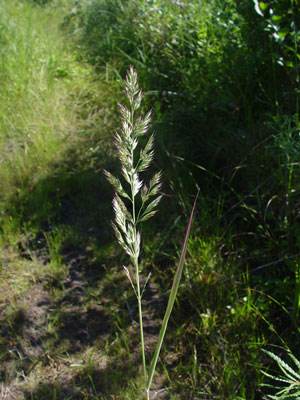DACF Home → Bureaus & Programs → Maine Natural Areas Program → Communities, Plants, and Animals → Rare Plants → Calamagrostis cinnoides

Calamagrostis cinnoides (Muhl) W. Bart.
Small Reed Grass
- State Rank: S3
- Global Rank: G5
- State Status: Special Concern
Habitat: Open areas: bogs, peaty meadows, wet rocks and shores. [Old field/roadside (non-forested, wetland or upland)]
Range: Nova Scotia , coastal states from Maine to Georgia, and less often inland to West Virginia, Ohio, Kentucky, and Tennessee.
Aids to Identification: Identification of species of the genus Calamagrostis is usually difficult and dependent upon rather technical characters. They are all perennial grasses with long, narrow leaves, and 1-flowered spikelets with a tuft of hairs at the base of the lemma.
This particular species grows to 0.6-1.2 meters. It is stout and smooth and the main leaf blades are 5-10 mm wide. The flowering cluster is dense and erect, 10-20 cm long, and the awn (a slender bristle) is attached above the middle of the lemma.
Ecological characteristics: Very little is known about the ecological characteristics of this species in Maine. It grows in open areas and clearings. Known occurrences have a patchy distribution, forming clones in open, sandy soil wetlands.
Phenology: Fruits August - October.
Family: Poaceae
Synonyms: Arundo cinnoides Muhl; Calamagrostis coarcta (Torr.) Torr. ex Eat.; Deyeuxia nuttalliana (Steud.) Vasey.
Known Distribution in Maine: This rare plant has been documented from a total of 13 town(s) in the following county(ies): Cumberland, York.
Reason(s) for rarity: At northern limit of range.
Conservation considerations: Currently known to occur in robust populations in a human-maintained shrub/herb habitat; management prevents encroachment of trees.